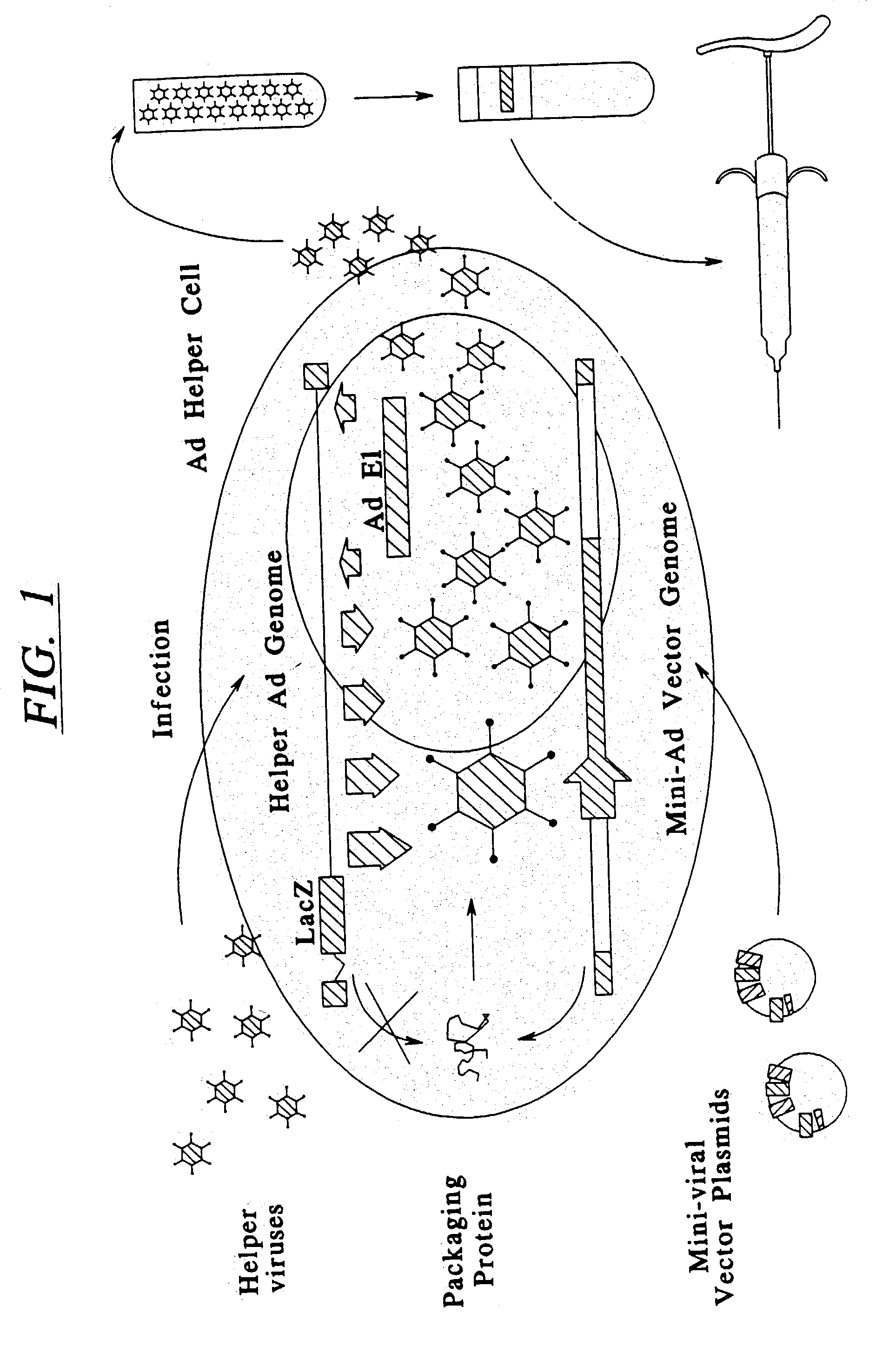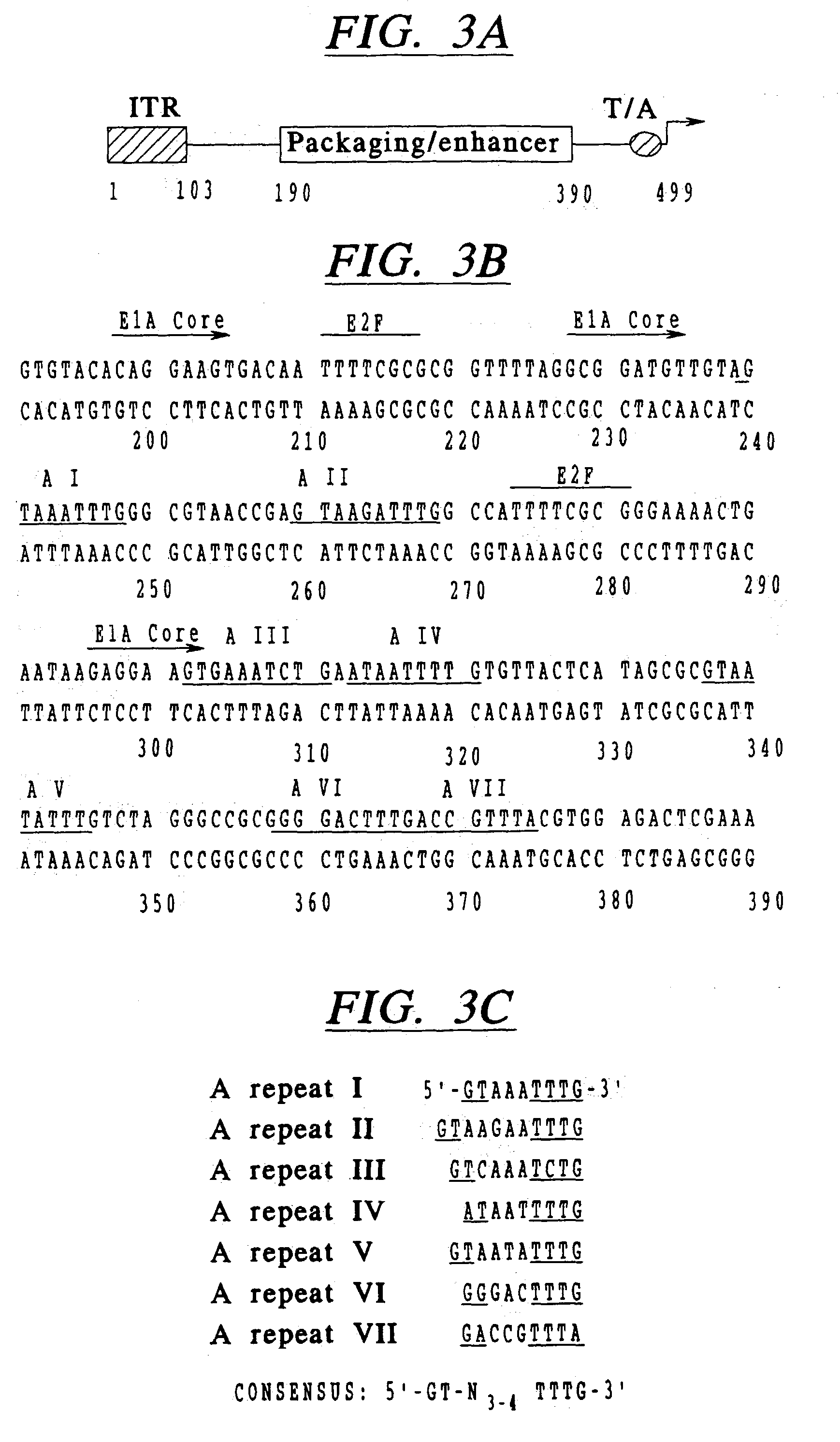Minimal adenoviral vector
a technology of adenovirus and vector, applied in the field of genetic medicine, can solve the problems of not reflecting the immunocompetent animals obtained using fuilly immunocompetent animals, and difficult to obtain high-level expression of fviii from retroviral vectors
- Summary
- Abstract
- Description
- Claims
- Application Information
AI Technical Summary
Benefits of technology
Problems solved by technology
Method used
Image
Examples
example 1
[0173] Construction and Characterization of The Packaging-Signal Mutated Helper Ad and Mini-Ad Vectors That Carry Green Fluorescence Protein (GFP) Reporter Gene
[0174] 1.1 Generation of the Packaging-Signal Mutated Helper Ad
[0175] Several packaging signal deletion-mutants of Ad5 have been described (90). Mutant d110 / 28 (also described as d1309-194 / 243:274 / 358) contains a deletion between nt 194 to 243 and between 274 to 358 of AdS. dlIO / 28 virus was generated by the method of Stow (89) by ligation of a plasmid containing the left end of Ad5 with this double mutation (pEIA-10 / 28) and the rest of Ad5 genome (90). dliO / 28 showed a 143-fold decrease in virus yield in a single virus infection and, when co-infected with wild type virus, was not detected. We reasoned that with a helper virus containing the same mutation as dllO / 28 we should be able to amplify the virus, although at low yields, and in the presence of mini-viral vector containing the wild type packaging signal the helper viru...
example 2
[0195] Design of Packaging-Signal Interfered Helper Ad
[0196] Since the packaging of adenovirus requires packaging proteins to bind the packaging elements (A repeats) (90, 96), and this invention introduces several specific DNA binding sequences adjacent to AdS packaging signals (A repeats) to further physically interfere helper virus packaging finction. Two DNA binding sequences have been chosen: A. GAL 4 binding sequence (97); B. tetracycline operator sequence (tetO) (98, 99). GAL4 is a sequence-specific DNA-binding protein that activates transcription in the yeast Saccharomyces cerevisiae. The first 147 amino acids of GAL4 binds to four sites in the galactose upstream activating region UAS.sub.G or a near consensus of the naturally occurring sites, the "17-mer" 5'-CGGAGTACTGTCCTCCG-3' or 5'-CGGAGGACTGTCCTCCG-3' (97). tetO comes from the Tn10 -specified tetracycline-resistance operon of E. coli, in which transcription of resistance-mediating genes is negatively regulated by the tet...
example 3
[0198] Construction and Characterization of Ad-E1 Helper Cell Lines
[0199] The majority of adenoviral vectors used in gene therapy applications were designed to have deletions in the E1 region of the adenovirus 5 (Ad5) genome. The E1 region, not including region IX, consists of 9% of the left end of Ad5 (1.2-9.8 map units), and encodes two early region proteins, EIA and E1B. Expression of ElA / EIB is required for virus replication and for expression of all other Ad5 proteins such as E2-E4 and late proteins (100). Deletion of E1 creates a replication-incompetent virus that, in theory, is silent for expression of all AdS proteins and expresses only the transgene of interest. Deletion of E1A and E1B is also of interest for safety reasons, since these two proteins, in combination, have been implicated in oncogenic transformation of mammalian cells (101-103). All of the Class I adenovirus vectors used to date in human clinical trials, as well as, the novel packaging-deficient helper virus ...
PUM
| Property | Measurement | Unit |
|---|---|---|
| apparent molecular weights | aaaaa | aaaaa |
| apparent molecular weights | aaaaa | aaaaa |
| time | aaaaa | aaaaa |
Abstract
Description
Claims
Application Information
 Login to View More
Login to View More - R&D
- Intellectual Property
- Life Sciences
- Materials
- Tech Scout
- Unparalleled Data Quality
- Higher Quality Content
- 60% Fewer Hallucinations
Browse by: Latest US Patents, China's latest patents, Technical Efficacy Thesaurus, Application Domain, Technology Topic, Popular Technical Reports.
© 2025 PatSnap. All rights reserved.Legal|Privacy policy|Modern Slavery Act Transparency Statement|Sitemap|About US| Contact US: help@patsnap.com



